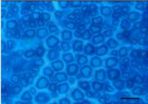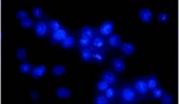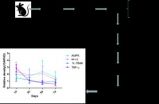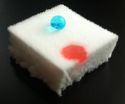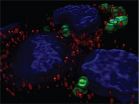(Press-News.org) Dr. Ruxu Zhang and colleagues from Third Xiangya Hospital, Central South University in China previously found that the K141N mutation in heat shock protein B8 (HSPB8) was responsible for Charcot-Marie-Tooth disease type 2L in a large Chinese family. Therefore, they generated a transgenic mouse model bearing the K141N mutation in the human HSPB8 gene, and to determine whether this K141NHSPB8 transgenic mouse model would manifest the clinical phenotype of Charcot-Marie-Tooth disease type 2L, and consequently be suitable for use in studies of disease pathogenesis. The K141NHSPB8 transgenic mice exhibited decreased muscle strength in the hind limbs and impaired motor coordination, but no obvious sensory disturbance at 6 months of age by behavioral assessment. Electrophysiological analysis showed that the compound motor action potential amplitude in the sciatic nerve was significantly decreased, but motor nerve conduction velocity remained normal at 6 months of age. Pathological analysis of the sciatic nerve showed reduced myelinated fiber density, notable axonal edema and vacuolar degeneration in K141NHSPB8 transgenic mice, suggesting axonal involvement in the peripheral nerve damage in these animals. These findings, published in the Neural Regeneration Research (Vol. 9, No. 4, 2014), indicate that the K141NHSPB8 transgenic mouse successfully models Charcot-Marie-Tooth disease type 2L and can be used to study the pathogenesis of the disease.
INFORMATION:
Article: " A novel transgenic mouse model of Chinese Charcot-Marie-Tooth disease type 2L," by Ruxu Zhang1, Fufeng Zhang2, Xiaobo Li1, Shunxiang Huang1, Xiaohong Zi1, Ting Liu1, Sanmei Liu1, Xuning Li1, Kun Xia3, Qian Pan3, Beisha Tang2, 3 (1 Department of Neurology, Third Xiangya Hospital, Central South University, Changsha, Hunan Province, China; 2 Department of Neurology, Xiangya Hospital, Central South University, Changsha, Hunan Province, China; 3 National Key Laboratory of Medical Genetics, Central South University, Changsha, Hunan Province, China)
Zhang RX, Zhang FF, Li XB, Huang SX, Zi XH, Liu T, Liu SM, Li XN, Xia K, Pan Q, Tang BS. A novel transgenic mouse model of Chinese Charcot-Marie-Tooth disease type 2L. Neural Regen Res. 2014;9(4):413-419.
Contact: Meng Zhao
eic@nrren.org
86-138-049-98773
Neural Regeneration Research
http://www.nrronline.org/
A novel transgenic mouse model of Chinese Charcot-Marie-Tooth disease type 2L
2014-05-06
ELSE PRESS RELEASES FROM THIS DATE:
Regulatory effects of glial cells on retinal synaptic plasticity
2014-05-06
Different types of retinal damage could induce plastic changes of retinal synapses, which might precede the serious damage of neuron soma. These morphological and functional changes to synapses after retinal injury could explain why many intervention measures protected neurons from death but failed to fully recover the damaged visual function. Therefore, it is necessary to investigate both the protection of synapses as well as protecting neurons from death. Dr. Lihong Zhou and co-workers from Central South University in China suggested that retinal glial cell activation ...
The Pael-R gene does not mediate the changes in rotenone-induced PD model cells
2014-05-06
Currently, the pathogenesis of Parkinson's disease is not entirely clear, but it has been generally considered to be the result of interactions among various genetic and environmental factors. Ting Zou and coworkers from Second Xiangya Hospital, Central South University in China previously found that Parkin mutation causes Parkin-associated endothelin receptor-like receptor (Pael-R) protein deposition, and the associated cytotoxicity leads to dopaminergic neuronal apoptosis. These researchers speculated that the Pael-R gene is possibly involved in the action of rotenone ...
AMPK and inflammatory mediators are involved in postoperative cognitive dysfunction
2014-05-06
Postoperative cognitive dysfunction is associated with neuronal apoptosis, which may result from post-surgery inflammation, the phosphorylation of tau protein and the accumulation of amyloid in aged people. 5′adenosine monophosphate-activated protein kinase (AMPK) can be involved in anti-inflammation, neuronal repair and anti-inflammation of the body through different downstream proteins and pathways. In addition, the activation of AMPK regulates tau protein phosphorylation and reduces amyloidogenesis in neurons. Yanlin Bi and co-workers from the Affiliated Qianfoshan ...
Danish social workers have become the moral agents of the state
2014-05-06
"We are turning the professional social workers into moral agents. This development recalls a time before the welfare state, when we had poor relief and when the extent to which the state could help you depended on your own dignity."
This is the assertion by Marie Østergaard Møller, who is associate professor at the Department of Political Science and Government, Aarhus University regarding the labour market policy that has been carried out in Denmark since the 1990s. More specifically, since 1994 the opportunities for citizens to get relief from the state have been reduced. ...
Hotspots of climate change impacts in Africa: Making sense of uncertainties
2014-05-06
Overlapping impacts of climate change such as drought or flooding, declining crop yields or ecosystem damages create hotspots of risk in specific parts of Africa. These are for the first time identified in a study now published by the Potsdam Institute for Climate Impact Research. The uncertainties in assessing the impacts do not necessarily hamper but can inform development strategies, according to the scientists. Likelihood and potential severity of impacts can be weighed to decide on suitable adaptation measures.
"We found three regions to be amongst those most at ...
Nanocellulose sponges to combat oil pollution
2014-05-06
All industrial nations need large volumes of oil which is normally delivered by ocean-going tankers or via inland waterways to its destination. The most environmentally-friendly way of cleaning up nature after an oil spill accident is to absorb and recover the floating film of oil. The Empa researchers Tanja Zimmermann and Philippe Tingaut, in collaboration with Gilles Sèbe from the University of Bordeaux, have now succeeded in developing a highly absorbent material which separates the oil film from the water and can then be easily recovered, "silylated" nanocellulose sponge. ...
Molecular switches age-related memory decline? Genetic variant protect against brain aging
2014-05-06
Philadelphia, PA, May 6, 2014 – Even among the healthiest individuals, memory and cognitive abilities decline with age. This aspect of normal aging can affect an individual's quality of life and capability to live independently but the rate of decline is variable across individuals. There are many factors that can influence this trajectory, but perhaps none more importantly than genetics.
Scientists are seeking to identify key molecular switches that control age-related memory impairment. When new molecules are identified as critical to the process of memory consolidation, ...
Yawning to cool the brain
2014-05-06
Common belief is that yawning helps to increase the oxygen supply. However, previous research has failed to show an association between yawning and blood oxygen levels. New research by a team of researchers led by Psychologist Andrew Gallup of SUNY College at Oneonta, USA now reveals that yawning cools the brain.
Sleep cycles, cortical arousal and stress are all associated with fluctuations in brain temperature, Yawning subsequently functions to keep the brain temperature balanced and in optimal homeostasis. According to this theory, yawning should also be easily manipulated ...
Exenatide has potential as a disease modifying agent in Parkinson's disease
2014-05-06
Amsterdam, NL, 5 May 2014 – A follow-up study of patients with Parkinson's disease (PD) who participated in an earlier "proof of concept" clinical trial using exenatide showed that improvements persisted twelve months after discontinuing exenatide therapy. These data provide strong encouragement for the further study of this drug in patients with PD, report researchers in the Journal of Parkinson's Disease.
Several recent discoveries have highlighted common cellular pathways that potentially relate neurodegenerative processes with abnormal mitochondrial function and abnormal ...
Genetic risk factor for premature birth found
2014-05-06
Researchers at the University of California, San Diego School of Medicine have discovered a genetic risk factor for premature birth. The risk factor is related to a gene that codes for a protein that the scientists have found helps the body's immune cells recognize and fight Group B Streptococcus (GBS) bacteria.
These bacteria are found in the vagina or lower gastrointestinal tract of approximately 15 to 20 percent of healthy women, but may cause life-threatening infections, such as sepsis or meningitis in newborns, especially those born prematurely.
The study is published ...
